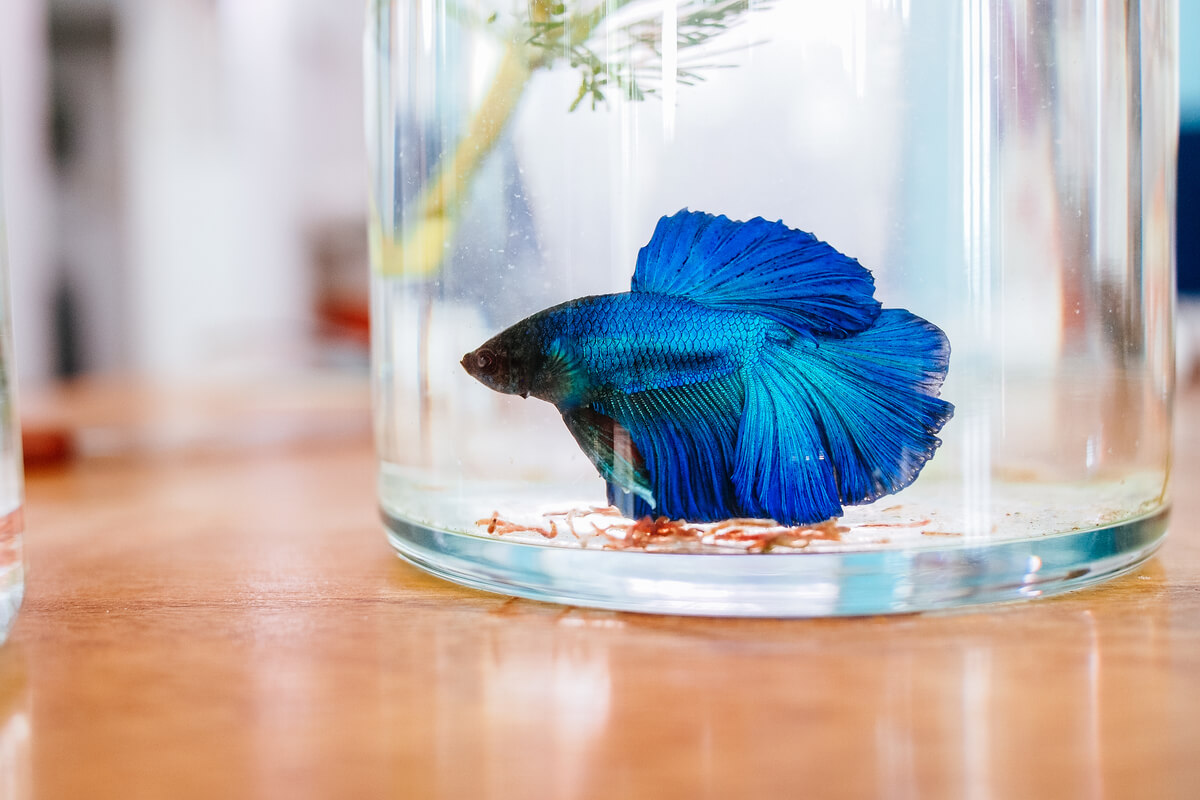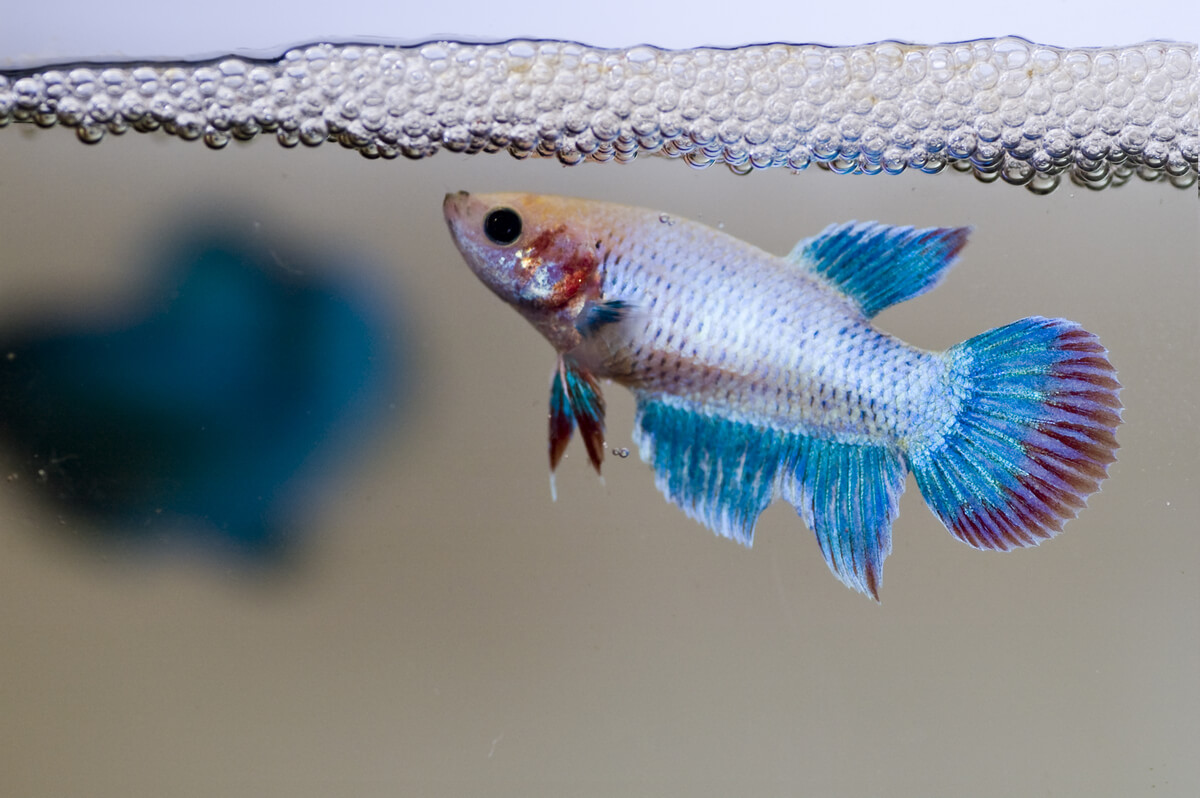Most Common Diseases in Betta Fish

Betta fish, known for their strong personality and aggressiveness, are a favorite among aquarium hobbyists. They’re robustly healthy animals as long as their aquarium is kept in proper conditions. If not, you’re likely to encounter some of the most common diseases in betta fish.
If you want to find out more about these diseases and how to prevent them, you’ve come to the right place. First of all, you’ll find information about the basic needs of this fish, followed by the diseases that appear when you don’t look after them correctly.
Basic needs of betta fish
The betta fish or Siamese fighting fish (Betta splendens) is a freshwater species belonging to the Osphronemidae family. It’s native to Thailand and Cambodia and its average life expectancy is 3 to 5 years.
Its diet is mainly carnivorous, as, in their natural surroundings, these fish consume mostly insects and larvae that they find in the waters. Sometimes they also feed on plant roots, but their diet mustn’t only be based on them, because they would end up suffering nutritional deficits.
It’s very important to carefully select the aquarium companions for betta fish; also keep in mind that females can live together if they have enough space, but males can’t. The ideal scenario will always be to keep each specimen alone, although people have been able to get docile species, such as guppies, to live peacefully with them.
They’re curious fish that recognize their owners and require a lot of environmental enrichment to prevent them from becoming frustrated and depressed.

The aquarium water should be fresh and treated with chlorine-removing agents. Use a low-flow filter and cycle the water for several weeks before placing the betta fish inside. This will allow time for the bacteria that break down the ammonia in the animal’s feces to proliferate.
The water temperature should be around 26° C (78° F)and be stable. It should never fall below 22° C (71° F). The pH shouldn’t be more acidic than 6.5, preferably neutral. Once a week, replace 1/3 of the aquarium water with clean water and remove debris from the bottom of the tank daily.
Common betta fish diseases
The basic care advice you have just read about will help you better understand why the most common betta fish diseases occur. Don’t ignore them, because knowing about them is essential in order to ensure the health of this beautiful fish.
Columnaris
Columnaris is a fungus that proliferates in the mouth of the betta fish and which gestates in aquariums and ponds. It’s easy to spot, as white cotton patch-like spots appear around the animal’s mouth, pectoral fin, and eventually all over the body.
The causes of this fungus are related to poor water cleanliness, filter problems, overcrowding of specimens, or the animal becoming stressed. It’s prevented by keeping these environmental conditions under control and by good aquarium cleaning.
Dropsy
This isn’t a disease as such, but a reflection of an internal pathological condition. It’s characterized by a swollen abdomen, small conical protuberances on the scales, a lack of appetite, and the need to breathe on the surface of the tank.
Dropsy has several causes, such as parasites, viruses, malnutrition and the presence of bacteria. When the pathologies caused by these agents progress and the general condition of the betta fish deteriorates, this syndrome appears.
Broken or frayed tail
This is one of the most common diseases in betta fish. The fins of this animal, thin and sinuous, are very sensitive to water quality (which also makes them a good indicator of health). When the water quality isn’t good enough to ensure the fish’s well-being, the tail is clearly torn and frayed.
Go immediately to the vet, because if you let the symptoms progress, gangrene will eventually appear and the fish will die.
Other symptoms, such as listlessness and the presence of white spots and reddening of the fin edges, are also seen in this pathology. However, this is a reversible condition with intensive water treatment in order to bring the parameters back to optimal ranges.
White spot
White spot disease is a disease caused by a protozoan, the Ichthyophthirius multifilis. It’s one of the most common diseases in aquariums and can be fatal if not treated in time.
Small white dots on the fish’s scales are visible to the naked eye. In addition, the betta fish become nervous and rub against objects and aquarium walls, as they feel itchy. If the disease progresses, breathing difficulties, lack of appetite, and finally death occur.
Septicemia
Septicemia is another common disease in betta fish. It’s a generalized infectious condition in the body due to a bacterial infection. When the betta fish is affected by bacteria in the water, it’s usually due to a combination of stress (which lowers the fish’s defenses) and poor water maintenance.
The disease is characterized by the presence of red spots all over the body, a lack of appetite and lethargy.
Your veterinarian will usually prescribe antibiotics and tell you how to improve your betta fish’s environment. Don’t administer any medication without a visit to the vet, as it isn’t easy to calculate the exact dosage.
Swim bladder disease
If you notice that your betta fish is swimming strangely, not keeping its balance, or moving sideways, it’s probably due to a problem in the swim bladder. This condition is usually due to bacterial infections and injuries sustained during transport (or from fights).
This condition requires moving the animal to a shallow tank (where it touches the bottom) and treating the water with medications prescribed by a veterinary professional. You should also change the water daily if it’s an infectious agent.

All fish are very dependent on the conditions of their aquatic environment. Therefore, if any of these diseases appear and you go to the vet, make sure that they help you regarding all the necessary aspects to ensure the health of your fish. In that way, you’ll be able to sit back and enjoy the curious personality of these special creatures.
All cited sources were thoroughly reviewed by our team to ensure their quality, reliability, currency, and validity. The bibliography of this article was considered reliable and of academic or scientific accuracy.
- Prapassorn, S. (1998). Disease and parasites of siamese fighting fish (Betta splendens Regan). In 15. RIT Annual Conference, Chiang Mai (Thailand), 12-14 Feb 1998.
- Betta splendens (Siamese Fighting Fish). (s. f.). Animal Diversity Web. Recuperado 17 de noviembre de 2021, de https://animaldiversity.org/accounts/Betta_splendens/
- Braddock, J. C., & Braddock, Z. I. (1955). Aggressive behavior among females of the Siamese fighting fish, Betta splendens. Physiological Zoology, 28(2), 152-172.
This text is provided for informational purposes only and does not replace consultation with a professional. If in doubt, consult your specialist.